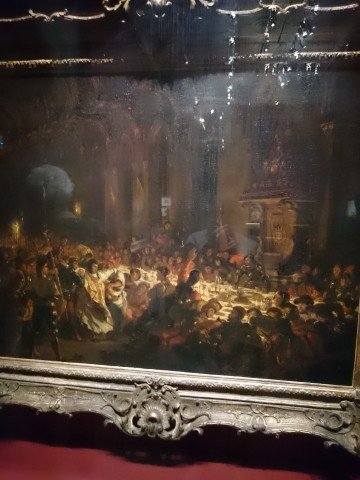At the Musée du Luxembourg to learn Paul Durand-Ruel’s lesson: defend art above all else
- Pierre Auguste Renoir, Charles and Georges Duran-Ruel, 1882, private collection.
- Pierre Auguste Renoir, Marie-Thérèse and Jeanne Duran-Ruel,1882, Norflok, Chrysler Museum of Art.
- Pierre Auguste Renoir, Joseph Durand-Ruel, 1882, private collection.
- Eugéne Delacroix, L’assassinat de l’évêque in Liége, 1829, Musée du Louvre.
- Alfred Sisley, Vue the Saint-Mammés, 1881. Pittsburgh, the Carnagie Museum of Art.
- Claude Monet, La Liseuse, 1872, oil on canvas, 50 x 65 cm. Baltimore, The Walters Art Museum. © The Walters Art Museum, Baltimore.
- Edgar Degas, Petites paysannes se lavant á la mer, ver soir, 1869-1875, oil on canvas. Private collection.
- Claude Monet, Green Park, Londres, 1870 ou 1871, oil on canvas, 34,3 x 72,5 cm. Philadelphia, Philadelphia Museum of Art. © Philadelphia Museum of Art.
- Claude Monet, Le Jardin de l’artiste, 1873, oil on canvas, 61 x 82,5 cm. Washington, National Gallery of Art © National Gallery of Art, Washington.
- Claude Monet, Le Jardin de l’artiste, 1873, oil on canvas, 61 x 82,5 cm. Washington, National Gallery of Art © National Gallery of Art, Washington.
- Claude Monet, Les Galettes, 1882, oil on canvas, 65 x 81 cm, Private collection. © Durand-Ruel & Cie.
- Pierre-Auguste Renoir, Paul Durand-Ruel, 1910, oil on canvas, 65 x 54 cm. Collection Durand-Ruel. © Durand-Ruel & Cie.
To picture the career of someone who had purchased closed to 12.000 artworks during his life is a difficult task even if you are a leading art institution such as the Musée d’Orsay, the National Gallery in London, or the Philadelphia Museum of Art. But the group of paintings this pool of museums has been able to gather together to celebrate the great French art dealer Paul Durand-Ruel – currently on display at the Musée du Luxembourg in Paris – is something rare to be seen, also in the realm of the highly exploited Impressionism movement.
From the three touching portraits of Durand-Ruel’s five children painted by Auguste Renoir in 1882, to some masterpieces like “L’assassinat de l’évêque in Liége” – painted by Eugéne Delacroix in 1829 and inspired by Walter Scott’s novel Quentin Durward (1823) –, and through some unconventional paintings such as Alfred Sisley’s Vue the Saint-Mammés (1881) – that was also the first Impressionist painting bought by an American Museum (the Carnagie Museum of Art in Pittsburgh) – or such as the hypnotic “Petites paysannes se lavant á la mer, ver soir” by Edgar Degas (1869-1875), the exhibition essentially proves how extraordinary artworks too need an enormous effort to be recognized.
In 1886 when, thanks to the help of the American art dealer James Sutton, Durand-Ruel arrived in New York with 289 paintings for sale – including 40 paintings by Claude Monet and Seurat’s masterpiece “Un dimanche après-midi à l’Île de la Grande Jatte ” (now in the collection of the Art Institute of Chicago) he was in a debt for 5 millions of francs, practically bankrupt. But those paintings were still too new, and too radical for the American art market.
Due to problem over duties (Landscape with figures: a history of art dealing in the United States, 2000) Durand-Ruel, 55 years old at that time, sold only 15 paintings out of the 289, for a total of $ 17,500 in receipts. Also the auction he organized the year after in New York was a failure; 34 years later, however, Durand-Ruel declared: «At last the Impressionist masters triumphed just as the generation of 1830 had. My madness had been wisdom. To think that, had I passed away at sixty, I would have died debt-ridden and bankrupt, surrounded by a wealth of underrated treasures… ».
Despite the hurdles he came across in his life, nowadays we ought to acknowledge that Durand-Ruel’s career was in the end a great success, if considering what Impressionism represents today. Like many of the great art dealers of the last two centuries, including Leo Castelli, Ernst Beyeler or Larry Gagosian, Durand-Ruel was a great innovator. His well known principles, that today may seem obvious, are still fundamental pillars: protect and defend art above all else; have the exclusivity of the artists’ production; support individual exhibitions; promote a network of international galleries; give free access to your galleries and your apartment; promote the artists’ work via the press; associate the art world with the finance world.
Furthermore, Durand-Ruel was against speculators, as proved by the facsimile of one of his administration books (livres des stock) on exhibition at the Musée du Luxembourg along with the artworks. Most of the times the selling price was just 20, or 30 per cent higher than the initial amount he paid for the artwork. Apparently that is the main difference from today scenery, in which young artists reach embarassing prices within a few years from the beginning of their career.
On the contrary, a clear similarity with the present time lies in the “physiological” beauty Durand-Ruel was interested in, and that he thought was what the new generation of bourgeois collectors needed in order to assert themselves. Is it the same kind of beauty – simple, objective, free from political or ethical meanings – that characterizes most of today’s massive production of abstract paintings? We do think so, even if nowadays the social landscape is quite different and the so-called middle class is under threat. It may be that the “Durand-Ruel” of the present time ought to be looked for in an active collector, more than in a brave and motivated entrepreneur.
December 9, 2014













